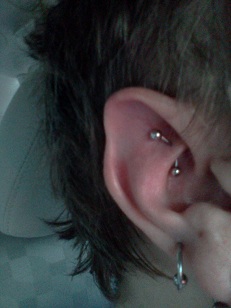Rook (piercing)
Rook piercing is a type of body piercing that is located along the antihelix of the ear's cartilage, specifically in the fold of cartilage that is between the outer ear and the ear canal. It is a popular choice for those looking to add to their ear piercings due to its unique placement and the ability to complement other ear piercings. The rook piercing can be adorned with a variety of jewelry types, including barbells, curved barbells, and rings.
Procedure[edit | edit source]
The process of getting a rook piercing involves a professional piercer using a hollow needle to puncture through the ear's cartilage. It is crucial to have this procedure done by an experienced piercer to minimize risks such as infection or improper placement. The area is cleaned and marked before the piercing is performed, and sterile equipment is used to ensure safety.
Healing and Aftercare[edit | edit source]
The healing time for a rook piercing can vary from person to person but typically ranges from 3 to 10 months. Proper aftercare is essential to ensure the piercing heals correctly and to reduce the risk of infection. This includes cleaning the piercing with a saline solution, avoiding touching or twisting the jewelry, and keeping the area clean and dry. It is also recommended to avoid sleeping on the pierced ear to prevent irritation and to promote healing.
Risks and Complications[edit | edit source]
As with any piercing, there are potential risks and complications associated with rook piercings. These can include infection, prolonged healing times, rejection or migration of the jewelry, and the development of keloids or other scar tissue. Choosing a reputable piercer and following proper aftercare instructions can help minimize these risks.
Jewelry[edit | edit source]
The choice of jewelry for a rook piercing can vary based on personal preference and the stage of healing. Initially, a longer barbell may be used to accommodate swelling, which can later be replaced with a shorter barbell, a curved barbell, or a ring once the piercing has healed. The gauge (thickness) of the jewelry typically ranges from 18 gauge to 16 gauge.
Cultural and Aesthetic Significance[edit | edit source]
Rook piercings have gained popularity in the body modification community for their aesthetic appeal and the ability to complement other ear piercings. They can be a statement piece on their own or part of a larger collection of ear piercings, known as an "ear project." The placement of the rook piercing allows for a variety of jewelry styles, making it a versatile choice for personal expression.
| This article is a stub. You can help WikiMD by registering to expand it. |
Search WikiMD
Ad.Tired of being Overweight? Try W8MD's NYC physician weight loss.
Semaglutide (Ozempic / Wegovy and Tirzepatide (Mounjaro / Zepbound) available. Call 718 946 5500.
Advertise on WikiMD
|
WikiMD's Wellness Encyclopedia |
| Let Food Be Thy Medicine Medicine Thy Food - Hippocrates |
Translate this page: - East Asian
中文,
日本,
한국어,
South Asian
हिन्दी,
தமிழ்,
తెలుగు,
Urdu,
ಕನ್ನಡ,
Southeast Asian
Indonesian,
Vietnamese,
Thai,
မြန်မာဘာသာ,
বাংলা
European
español,
Deutsch,
français,
Greek,
português do Brasil,
polski,
română,
русский,
Nederlands,
norsk,
svenska,
suomi,
Italian
Middle Eastern & African
عربى,
Turkish,
Persian,
Hebrew,
Afrikaans,
isiZulu,
Kiswahili,
Other
Bulgarian,
Hungarian,
Czech,
Swedish,
മലയാളം,
मराठी,
ਪੰਜਾਬੀ,
ગુજરાતી,
Portuguese,
Ukrainian
Medical Disclaimer: WikiMD is not a substitute for professional medical advice. The information on WikiMD is provided as an information resource only, may be incorrect, outdated or misleading, and is not to be used or relied on for any diagnostic or treatment purposes. Please consult your health care provider before making any healthcare decisions or for guidance about a specific medical condition. WikiMD expressly disclaims responsibility, and shall have no liability, for any damages, loss, injury, or liability whatsoever suffered as a result of your reliance on the information contained in this site. By visiting this site you agree to the foregoing terms and conditions, which may from time to time be changed or supplemented by WikiMD. If you do not agree to the foregoing terms and conditions, you should not enter or use this site. See full disclaimer.
Credits:Most images are courtesy of Wikimedia commons, and templates, categories Wikipedia, licensed under CC BY SA or similar.
Contributors: Prab R. Tumpati, MD

